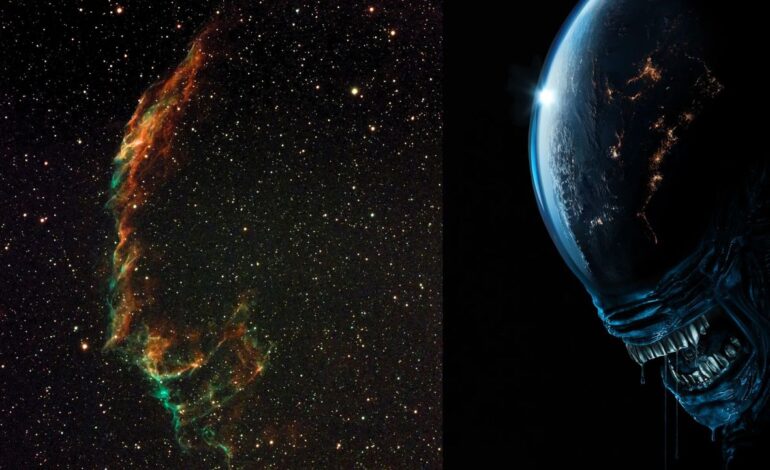Amateur Astronomer Captures Veil Nebula, Sees Xenomorph Shape

A recent astrophotography session led to an unexpected discovery for an amateur astronomer. While observing the Veil Nebula through a Vaonis Vespera Pro smart telescope, the astronomer noted a striking resemblance to a Xenomorph from the iconic film franchise “Alien.” This intriguing shape emerged during observations conducted on August 8 and August 12, 2023, totalling approximately 1.5 hours of imaging.
The Veil Nebula, located about 2,400 light-years away in the constellation Cygnus, represents the visible portion of the broader Cygnus Loop. This nebula is a supernova remnant, formed by the explosion of a star roughly twenty times the mass of our sun, occurring around 10,000 years ago, according to NASA. The eastern section, catalogued as NGC 6992, displays glowing arcs of ionized oxygen and hydrogen, creating a captivating view of stellar debris that continues to expand long after the star’s demise.
Unexpected Shapes in the Cosmos
Using a dual-band filter to overcome light pollution and the brightness of the full moon, the astronomer managed to capture the delicate tendrils of gas that constitute the Veil Nebula. The resulting stacked JPEG image revealed features that, when viewed from a specific angle, bore an uncanny likeness to the Xenomorph, the alien creature known for its menacing appearance. The image has sparked conversations online, particularly with the recent buzz surrounding the new series “Alien: Earth,” created by Noah Hawley. This series blends elements of corporate dystopia with the horror of Xenomorphs, and its eight-episode premiere was released on August 12, 2023 on FX and Hulu in the U.S., followed by a release on Disney+ in the U.K. and Europe on August 13, 2023.
For those interested in capturing the Veil Nebula for themselves, a telescope with at least a 4-inch (100mm) aperture is recommended, ideally in areas with minimal light pollution. Utilizing a nebula filter, such as an O III filter, can enhance visibility of its faint filaments. Astrophotographers often use small refractors with short focal lengths (around 200-500mm) and long exposures to frame the entire nebula and reveal its intricate structure.
Challenges of Urban Observations
The amateur astronomer successfully captured this image from a suburban location rated as Bortle 7 on the light pollution scale, which ranges from Class 1 (dark-sky sites) to Class 9 (bright inner-city skies). Despite being far from ideal conditions for observing faint deep-sky objects, the use of advanced equipment like the Vaonis Vespera Pro allowed for remarkable results.
The Veil Nebula continues to be a popular target for both amateur and experienced astronomers, even with its unexpected resemblance to a science fiction icon. With the growing interest in astronomy, particularly in light of recent cultural phenomena like “Alien: Earth,” the cosmos remains a source of wonder and inspiration.






